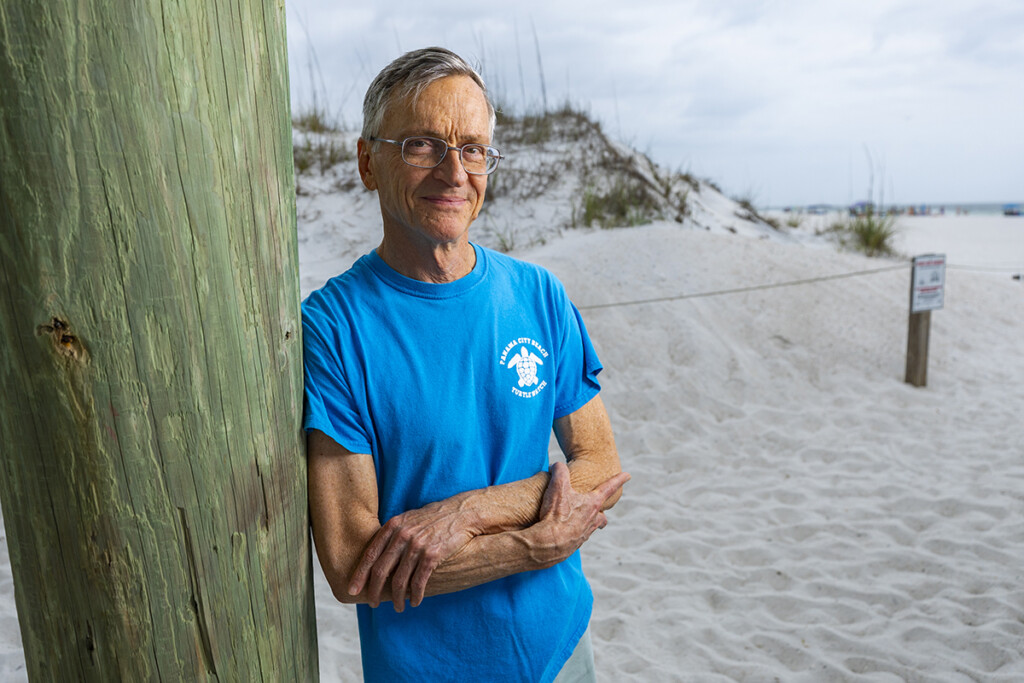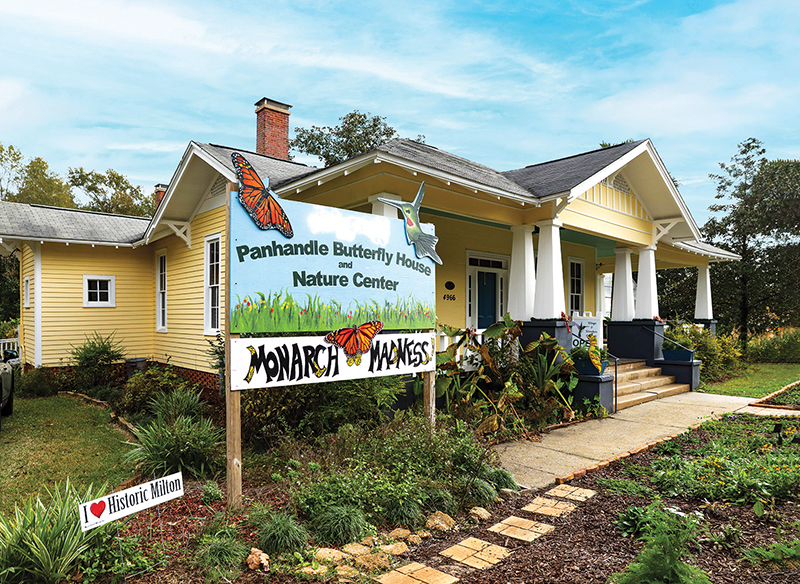Saving the Turtles
A turtle watcher’s tenure ensures safe nesting and hatching along Panama City Beach

They ride at dawn.
Hours before Panama City Beach bustles with sunbathers, surfers and shore fishers, experienced surveyors armed with stakes, mallets and tape arrive to scour the sand.
But what may sound like a bizarre scene is routine for the Panama City Beach Turtle Watch during sea turtle nesting season, May through October.
Signs a turtle has nested begin with a noticeable “crawl,” that is, a track ranging from 2 ½ to 4 feet wide in diameter, depending on the species. According to Kennard Watson, director of the PCB Turtle Watch, the loggerhead and green sea turtles are most commonly cataloged along Gulf Coast beaches.
“Our surveyors can determine if a sea turtle has made its nest by following these crawls, where they’ll typically discover a large amount of disturbed sand where a female has laid and buried her eggs,” Watson said. “From there, they contact our volunteers who help mark and monitor the nest until its hatching, about two months later.”
For Watson, protecting hatchlings in Bay County has been a 33-year endeavor. Originally from Pensacola, Watson said it wasn’t until he accepted a research engineering role at the Naval Surface Warfare Center Panama City Division that he became aware of sea turtles nesting along the Gulf.

Kennard Watson, director, PCB Turtle Watch. Photo by Mike Fender
“I took a class on sea life in St. Andrews Bay at the local community college and learned about them for the first time,” Watson recalled. “My job meant most of my time was spent behind a computer, so I was in search of a new hobby that would get me out on the beach. One thing led to another, and through a local conservation group, I was able to start a nest monitoring program.”
Back in the early ’90s, Watson said his crew was met with “a lot of blank stares” upon being confronted by curious beachgoers and divulging they were on the lookout for sea turtles.
“The attitude back then was that sea turtles belonged in parks or natural wildlife refuges, not urban beaches like ours,” he said.
Mindsets toward these precious species have clearly reformed. Last year, 30 out of 46 recorded nests produced 2,518 hatchlings. Nine of these nests belonged to green sea turtles, more than the watch recorded in any year prior.

Panama City Beach Turtle Watch recorded 46 nests during the 2023 nesting season. Of those, 30 nests produced 2,518 hatchlings. The 16 unsuccessful nests were attributed to Hurricane Idalia wash over. Photo by Mike Fender
“I like to think that success, in part, has to do with our efforts and working in concert with other groups like ours across the coast,” Watson said. “Regulations are still a work in progress, but we’ve come a long way in three decades.”
Watson said enforcement of turtle excluder devices, which allow turtles to safely exit trawl nets, has played a role in species preservation. Too, Watson’s watch has been proactive in petitioning for wildlife-friendly lighting along the Bay County beachfront, a threat Watson considers to be the most severe to both nesting turtles and hatchlings.
“We know from data we’ve collected over the years that over half of nocturnal emergent hatchlings are disrupted by artificial light pollution, so they wouldn’t reach the water were it not for our intervention,” Watson said. “Luckily, it’s a problem that can be solved. There are ordinances now in place to ensure beachfront homeowners use lights that are properly shielded, and utilize a color-emitting light source that doesn’t disrupt sea turtle navigation.”
Operating under State Permit 038, the watch is allowed 25 volunteers and paid surveyors backed by the Bay County Tourist Development Council. Apart from observing nests, these volunteers embark on redirection rescue missions and, in rare cases, relocate nests to safer areas.
Watson is passionate about the watch’s educational outreach programs. In addition to school visits, they allow classes and scout troops to “adopt” a nest. “Essentially, we create an outdoor classroom where children can visit their nest, take inventory and see how well it did,” Watson said.

Surveyor Nancy Evou inspects a hatchling nest near Pier Park where beachgoers visit in droves each day. Photo by Mike Fender
When asked what kids get a kick out of the most, Watson said it’s the turtle trivia. “They’re shocked to learn that whether a hatchling is a male or female is determined by the temperature at which the egg incubates,” he said. “And it never ceases to amaze them that it takes turtles longer to grow up than them, about
30 years or so.”
By that logic, Watson’s watch has reached maturity. He has plans to soon retire from his three-decade role. This year, he’s sharing leadership duties with longtime turtle watcher Angela Barros, who will then assume his position as director in 2025.
The program will endure, and Watson expects even greater things to come under new leadership.
“Thirty years from now, hatchlings who have imprinted on Panama City Beach will return to lay their own eggs,” Watson said. “It’s our responsibility to see they have a nice homecoming.”
Support the Mission
Panama City Beach Turtle Watch director Kennard Watson says the best way to support the watch’s mission is by keeping our beaches clean, dark and flat.
When leaving the beach, dispose of any trash and grab all belongings. At night, minimize light usage or use turtle-safe lighting. And always be sure to fill in holes, big and small, and flatten mounds and sandcastles.
» To report a nesting turtle or hatchlings, call Panama City Beach Police at (850) 233-5000. To report injured wildlife, call the Wildlife Hotline at (888) 404-3922.

